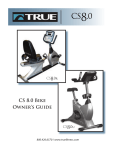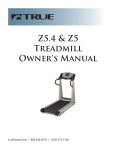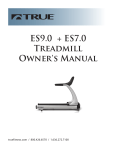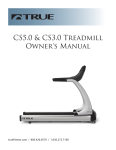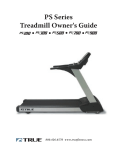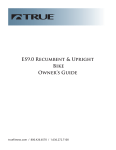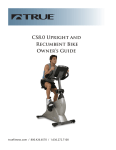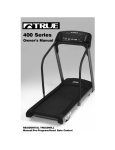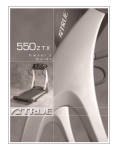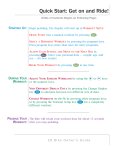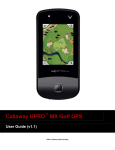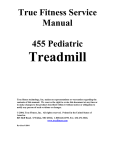Download True Fitness CS4 Treadmill User Manual
Transcript
Commercial Series Treadmill Owner’s Guide 800.426.6570 / www.truefitness.com Thank You For Selecting True Today True also produces award-winning exercise bikes, ellipticals, and TrueStretch, our patented flexibility unit. In 1981 Frank Trulaske launched True Fitness Technology with one goal in mind – to make the finest fitness equipment on the market. His team began by manufacturing premium, handcrafted treadmills with a focus on quality and durability. Now, 25 years later, True Fitness has established its reputation as one of the oldest and most respected fitness equipment manufacturers worldwide. “Our original goal was to build the world’s best fitness equipment, and today we believe we’re doing it!” -Frank Trulaske While True treadmills continue to enjoy top reviews from major consumer magazines and fitness experts, its line of products has expanded. True Fitness is dedicated to always staying a step ahead of the competition and supplying its valued customers with the finest workout equipment in the industry. True’s equipment is designed to accommodate the needs of everyone from the professional athlete to the weekend warrior. So, with a solid 25 years of fitness experience, you can count on True Fitness both now and in the future to meet your goals for a happy, healthy lifestyle. Review for Your Safety IMPORTANT SAFETY INSTRUCTIONS When using this exercise machine, basic precautions should always be followed, including the following: Read all instructions before using this treadmill. Consult your physician before beginning any exercise program. Do not use if you have a cold or fever. Warning: to reduce the risk of burns, fire and electric shock and injury to persons, follow these instructions: Danger: To reduce the risk of electric shock, always unplug the treadmill before cleaning. Unplug it from the outlet when not in use and before any service is performed. Keep the power cord away from heated surfaces. Never operate this treadmill if it has a damaged power cord or plug, if it is not working properly, if it has been damaged or dropped, or if it has been submerged in water. In these cases, this treadmill should be examined by a qualified service technician. 4 CS Treadmill Owner’s Guide Review for Your Safety IMPORTANT SAFETY INSTRUCTIONS Other safety precautions: Close supervision is necessary when the treadmill is being used by or near children, or disabled persons. Use this treadmill only for its intended use as described in this manual. Do not use attachments not recommended by the manufacturer. Never drop or insert any object into any opening. Do not allow animals on or near the treadmill. Use the treadmill indoors only. Never use the treadmill near water or while wet. Using this treadmill around a pool, hot tub or sauna will void the warranty. Do not operate where aerosol (spray) products are being used or where oxygen is being administered. Allow only trained personnel to service this equipment. Avoid the possibility of bystanders being struck or caught between moving parts by making sure that they are out of reach of this treadmill while it is in motion. Allow only one person at a time on this treadmill. CS Treadmill Owner’s Guide 5 Table of Contents Front Section 1 - Basic Operation 2 - Heart Rate Control page 11 page 21 3 - User Programs 4 - Fitness Tests 5 - Fan page 29 page 31 page 35 6 - Designing an Exercise Program 7- Care and Maintenance Appendix A page 37 page 45 page 49 Appendix B Appendix C Appendix D page 51 page 53 page 55 Safety instructions, Quick Start Guide, Table of Contents, Model Differences and Starting and Stopping the Treadmill Safely. page 3 Three different types 6 CS Treadmill Owner’s Guide Quick Start Guide Before Your Workout Quick Start into a manual workout by pressing , or set up a different workout by selecting a workout and adjusting settings keys or numeric keys and press to if necessary. Use accept each setting. During Your Workout Adjust speed or incline at any time by using the dedicated speed and incline keys on the control pod or keyboard. Change data readouts by pressing Pause your workout by pressing Starting And Stopping Your Treadmill Safely . . Place your feet on the straddle covers. Attach the safety lanyard to your waistband. Place the safety key on the key holder. Set up your workout (see Chapter 1) and press . Stop the treadmill by reducing speed to 2 mph, then press CS Treadmill Owner’s Guide . 7 Model Differences This new treadmill is part of the True Commercial Series treadmills. Since this owner’s guide covers all three commercial models, you might notice descriptions of features that are different from your treadmill. The main differences are in the consoles. Adds to CS 8.0: • 8 Pre-set programs • Heart rate control • Cooling fans • Two window LCD display • 3% decline CS 6.0 Same as CS 8.0 except: • Single window LCD display • No decline 8 CS Treadmill Owner’s Guide Model Differences Model Differences CS 4.0 • “Simple” LED display • All controls on main keyboard • Manual operation only CS Treadmill Owner’s Guide 9 chapter one Basic Operations In This Chapter: Using the Keyboard Quick Speed Heart Rate Monitoring Pre-Set Workouts Actual Speed Display Chapter 1: Basic Operations Chapter 2: The Console Chapter 3: User Programs Chapter 4: Fitness Tests Chapter 5: Fan Accessories Chapter 6: Designing an Exercise Program Chapter 7: Care and Maintenance 11 Using the Keyboard CHAPTER ONE: BASIC OPERATIONS Selecting Workouts: Press any of the workout keys and press to begin your workout using the default settings. , you Before pressing may adjust other settings like Workout Time and Body Weight, pressing after adjusting each setting. Press at any time to begin your workout. Note that HRC workouts require settings adjustments. CS 6.0 and CS 8.0 Workout Keys Adjusting Settings: Use the numeric keypad or the keys to adjust numeric settings. to accept each Press settings adjustment. Control Pod / Primary Controls: During your workout, press to stop the treadbelt and pause your workout. Press to resume your workout. Press and hold to clear your workout. Change Data Display: During your workout, press change the data displayed. to Safety Lanyard: This magnetized cord must be in place on the treadmill balance bar location, and should be attached to your clothing. The treadmill will not operate if the lanyard is not attached. 12 CS Treadmill Owner’s Guide Using the Keyboard Manual Operation CHAPTER ONE: BASIC OPERATIONS Quick Speed Important: Quick speed keys change speed with a single key press, so take care in the keys you press. Press , lighting the enable LED. Now the numeric keys function as speed change keys from 1 mph to 9 mph. Quickspeed is functional in any workout except fitness tests and Heart Rate Control. Disable QuickSpeed by pressing Body Weight again. During workout set up, set a correct body weight including clothes so the treadmill can better estimate your calorie expenditure. CS Treadmill Owner’s Guide 13 Heart Rate Monitoring CHAPTER ONE: BASIC OPERATIONS This treadmill can monitor your heart rate using either a chest strap or the metal grips on the hand rails (called contact heart rate or CHR pads). A chest strap transmits your heart rate to the treadmill via radio, and the CHR pads connect to a special computer circuit to extract your heart rate. Monitoring Your Heart RAte Although this treadmill functions fine without using the heart rate monitoring feature, this kind of monitoring gives you valuable feedback on your effort level. Chest strap monitoring also allows you to use Heart Rate Control, the most advanced exercise control system available. When you wear a Polar® or compatible transmitter strap, the treadmill will display your heart rate as a digital beats-per-minute (bpm) readout. The transmitter strap should be worn directly against your skin, about one inch below the pectoral muscles/breast line (see picture). Women should be careful to place the transmitter below their bra line. Some moisture is necessary between the strap and your skin. Sweat from your exercise works best, but ordinary tap water may be used prior to your workout if desired. 14 CS Treadmill Owner’s Guide Chest Strap Heart Rate Monitoring Contact Heart Rate CHAPTER ONE: BASIC OPERATIONS Contact Heart Rate (CHR) The contact heart rate (CHR) system lets you monitor your heart rate without wearing a strap. Gently grasp the contact heart rate pads as shown. When the system detects your hands, the Heart Rate label will start flashing in time with your heart beat. During this time, the system is analyzing and locking in your heart rate. Within about 15 seconds, your digital heart rate in beats per minute should be displayed. Important: The CHR System should only be used while walking at speeds of 4 mph or lower. Above this speed the CHR accuracy is unavoidably unreliable due to large muscle movements. CS Treadmill Owner’s Guide 15 Contact Heart Rate CHAPTER ONE: BASIC OPERATIONS 1. Exercise with smooth body motions. 2. Breathe smoothly and regularly, and avoid talking. (Talking will cause unrepresentative heart rate spikes of 5 to 10 bpm.) 3. Grip the pads lightly, not tightly. 4. Make sure your hands are clean, free of both dirt and hand lotions. When using a Heart Rate Control workout, it is best to use chest strap monitoring. These workouts work best with the extra accuracy gained from a chest-contact heart rate monitoring system. A Note on CHR Accuracy CHR monitoring may be a bit less accurate than a chest strap, since the heart rate signals are much stronger at the chest. About 5% of the population cannot be picked up by any CHR system. This is because their heart is positioned in a more up-and-down manner in their chest, as opposed to leaning over to one side. 16 CS Treadmill Owner’s Guide For Best CHR Results Pre-Set Workouts CHAPTER ONE: BASIC OPERATIONS Pre-Set Workouts Each workout has a four-minute warm up and a two-minute cool down. Speed or grade changes stay in effect until the next change is requested by the program. Changing the default workout time adds or removes segments; it does not stretch or compress the workout profile. Change workout levels during your workout by pressing the key for the workout you are using (its LED will be lit), adjusting the numeric level, then pressing . Change to a new pre-set workout during your workout by pressing any of the present at your desired workout. workout keys and pressing Walking: Calorie Burn In a walking workout, all speeds are under 4 mph. Increasing levels increases speed from 2 to 4 mph and grade from 4% to 10%; speed and grade stay constant in the work section. Speed or grade changes in the work section are permanent Changes in Grade Walking: Hill Intervals Walking intervals with grade alternate between hills and nearly flat in two-minute segments. Speed changes are permanent; grade changes affect the current two-minute segment only. Changes in Grade CS Treadmill Owner’s Guide 17 Pre-Set Workouts CHAPTER ONE: BASIC OPERATIONS Zero-grade walking or running intervals are in one-minute segments. Grade changes are permanent; speed changes affect the current one-minute segment only. Walking and Running: Speed Intervals Changes in Speed Zero-grade gradually increases speed then decreases speed, changing once per minute. Grade changes are permanent; speed changes affect the current one-minute segment only. Changes in Speed 18 CS Treadmill Owner’s Guide Walking and Running: Speed Ramp-Up Classic Pre-Set Workouts CHAPTER ONE: BASIC OPERATIONS These are True’s original four pre-set workouts. Changing the workout time stretches and compresses the workout profile, in ontrast to the four new pre-set workouts. Other differences are explained below in the individual workout sections. Glute Buster Incline changes in varying amounts in contrast to the new Hills workout, which has hills of the same size all throughout the workout. Leg Shaper Very similar to Hill Intervals, with varying incline changes. Cardio Challenge Similar to Speed Ramp, except both speed and grade change. = Incline = Speed CS Treadmill Owner’s Guide 19 Classic Pre-Set Workouts CHAPTER ONE: BASIC OPERATIONS Different from Speed Intervals 2 with the speed changing in varying amounts. Sports Training When the treadmill is changing to a new target speed, the matrix display readout will display the actual speed. As the speed is changing, the message center will display Actual Speed Display TARGET = 12.0 MPH Once the treadmill reaches the new target speed, the Speed readout will show the target speed. 20 CS Treadmill Owner’s Guide chapter two The Console In This Chapter: Keyboard Function Display Chapter 1: Basic Operations Chapter 2: The Console Chapter 3: User Programs Chapter 4: Fitness Tests Chapter 5: Fan Accessories Chapter 6: Designing an Exercise Program Chapter 7: Care and Maintenance 21 CS 8.0 Keyboard CHAPTER TWO: THE CONSOLE Enter Accepts workout parameters, and toggles the dual function displays. Activate Quickspeed Enables the numeric keys to function as speed change keys from 1 mph to 9 mph. This is functional in any workout except fitness tests and heart rate control. Speed Slow/Fast Adjusts speed in 0.1 mph increments. Also used to set weight and other workout parameters. HRC Cruise Control While in any workout, set your current heart rate as the target heart rate. Stop/Pause Stops the belt and pauses workout. If held for 3 seconds, resets all workout information. Numeric Keys Direct entry of numeric data. CS 8.0 Treadmill Keyboard Cool Down Time period to cool down muscles and lower heart rate. Reset Resets treadmill completely. Advanced Options Identical to User programs and pressing and fitness tests. holding STOP. Incline Up/Down Adjusts incline. Also used to choose programs. Start/Quick Start Starts the belt and begins the workout. CS Treadmill Owner’s Guide 22 CS 8.0 Display CS 8.0 Treadmill Display CHAPTER TWO: THE CONSOLE CS Treadmill Owner’s Guide 23 CS 6.0 Keyboard CHAPTER TWO: THE CONSOLE Enter Accepts workout parameters, and toggles the dual function displays. Activate Quickspeed Enables the numeric keys to function as speed change keys from 1 mph to 9 mph. This is functional in any workout except fitness tests and heart rate control. Speed Slow/Fast Adjusts speed in 0.1 mph increments. Also used to set weight and other workout parameters. HRC Cruise Control While in any workout, set your current heart rate as the target heart rate. Stop/Pause Stops the belt and pauses workout. If held for 3 seconds, resets all workout information. Numeric Keys Direct entry of numeric data. CS 6.0 Treadmill Keyboard Cool Down Time period to cool down muscles and lower heart rate. Reset Resets treadmill completely. Advanced Options Identical to User programs and pressing and fitness tests. holding STOP. Incline Up/Down Adjusts incline. Also used to choose programs. Start/Quick Start Starts the belt and begins the workout. CS Treadmill Owner’s Guide 24 CS 6.0 Display CS 6.0 Treadmill Display CHAPTER TWO: THE CONSOLE 25 CS Treadmill Owner’s Guide CS 4.0 Keyboard CHAPTER TWO: THE CONSOLE Reset Resets treadmill completely. Identical to pressing and holding STOP. Incline Up/Down Adjusts incline. Enter Accepts workout parameters. Activate Quickspeed Enables the numeric keys to function as speed change keys from 1 mph to 9 mph. Speed Slow/Fast Adjusts speed in 0.1 mph increments. Also used to set weight and other workout parameters. CS 4.0 Treadmill Keyboard Numeric Keys Direct entry of numeric data. Start/Quick Start Starts the belt and begins the workout. Stop/Pause Stops the belt and pauses workout. If held for 3 seconds, resets all workout information. CS Treadmill Owner’s Guide 26 Time Time remaining in your workout. (This is elapsed time in default Manual mode or Quick Start.) Pace Time per mile at current speed. Heart Rate Beats per minute of the heart. Incline Incline in percent grade of 0.5% increments. Calories Estimated total calories burned. Speed Miles per hour in 0.10 increments. Track Distance Simulates a running track Miles traveled in 0.01 mile increments up to 9.99 miles, or 0.10 mile increments past 10 miles. Can also be set to count down. CS 4.0 Treadmill Display CS 4.0 Display CHAPTER TWO: THE CONSOLE CS Treadmill Owner’s Guide 27 chapter three User Programs In This Chapter: How to Record and Run User Programs Chapter 1: Basic Operations Chapter 2: The Console Chapter 3: User Programs Chapter 4: Fitness Tests Chapter 5: Fan Accessories Chapter 6: Designing an Exercise Program Chapter 7: Care and Maintenance 29 How to Record & Run User Programs CHAPTER THREE: USER PROGRAMS During a manually-controlled workout, the CS 6 and 8 treadmills always "record" the changes you make in speed or incline. They can save up to three User Programs Note that this workout recording only takes place when you press Quick Start only and use the default manual mode settings; you cannot choose a target workout time or distance. Time must count up during your workout in order to be recorded. Up to 36 changes in speed or incline can be recorded. Each speed/incline pair of changes must be separated by at least 30 seconds. To save a manual workout, press as you normally would to end your workout. Now press and hold until the display shows Save User 1. You can save your workout in User 1, or press to select User 2 or User 3. Press and hold to save the workout program you have selected. To use a User Program that you have saved, simply select it from the list of programs under the Advanced Options key. 30 CS Treadmill Owner’s Guide How to Record and Run User Programs chapter four Fitness Tests In This Chapter: About the Gerkin Fitness Test Running the Gerkin Test Military Fitness Tests Chapter 1: Basic Operations Chapter 2: The Console Chapter 3: User Programs Chapter 4: Fitness Tests Chapter 5: Fan Accessories Chapter 6: Designing an Exercise Program Chapter 7: Care and Maintenance 31 Gerkin Fitness Test CHAPTER FOUR: FITNESS TESTS One way to measure your overall fitness is to take a Gerkin fitness test. Named after the Arizona researcher who designed this test, this submaximal treadmill test (submaximal means you work below maximum effort) is used to predict VO2 max: the volume of oxygen you can consume while exercising at your maximum capacity. This particular test has gained great popularity in the firefighter and law enforcement community. Like most fitness tests, it is classified as a graded exercise test (GXT). The test is stopped at the point your heart rate reaches 85% of your agepredicted maximum. About the Gerkin Test Select the Gerkin test under the Advanced Options key. Enter your age, which is used to calculate your test termination point. The version of the Gerkin Protocol that True Fitness The Gerkin protocol starts uses in its exercise machines at 4.5 miles per hour at a is the new equation of 0% incline. It then increases 205.8 – 0.685*age. To better speed or incline every 60 understand why we selected seconds. For example, at the this method over the outdated seven-minute mark, the speed “220 – age” maximal heart increases to 6 miles per hour rate equation, you can review while the incline raises to 8%. the scientific paper in Journal When your heart rate reaches of Exercise Physiology, a PDF 85% of your age-predicted document located at http:// maximum, the test waits for www.asep.org/Documents/ your heart rate to exceed the Robergs2.pdf. target for 15 seconds, then terminates the test. Running the Gerkin Test 32 CS Treadmill Owner’s Guide Accuracy of the Gerkin Test CHAPTER TWO: FITNESS TESTS Accuracy of The scientific journal, Occupational Medicine, published a study the Gerkin in 2004 on the accuracy of the Gerkin test. The conclusion: Test “The Gerkin treadmill protocol overpredicts VO2max in healthy men and women and, therefore, should not be used for predicting VO2max in individual firefighters, particularly if VO2max is a criterion for inclusion or exclusion from duty. At this time, a valid treadmill running test is needed for predicting the VO2max value of individual firefighters.” However, for the fitness enthusiast who is interested in monitoring their fitness level, the Gerkin test can be used to measure progress over time. CS Treadmill Owner’s Guide 33 Military Fitness Tests CHAPTER FOUR: FITNESS TESTS Each of the four service branches has their own fitness test protocol. All of them work in the same basic way: you input personal information, then run a set distance as fast as you can. A score will then be displayed based on the scoring table for the chosen protocol. Warning: You must take great care when running a maximal test on a treadmill. As you tire, your balance may diminish. Always use extreme caution to prevent excessive fatigue. Army Test 1. Enter sex. 2. Enter age. 3. Press Start to run 2-mile test. Navy Test 1. 2. 3. 4. Enter sex. Enter age. Enter above or below 5000-foot altitude. Press Start to run 1.5-mile test. Air Force Test 1. Enter sex. 2. Enter age. 3. Press Start to run 1.5-mile test. Marines Test 1. Enter sex. 2. Press Start to run 3-mile test. 34 CS Treadmill Owner’s Guide Military Fitness Tests chapter five Fans In This Chapter: Fans on CS Treadmills Chapter 1: Basic Operations Chapter 2: The Console Chapter 3: User Programs Chapter 4: Fitness Tests Chapter 5: Fan Accessories Chapter 6: Designing an Exercise Program Chapter 7: Care and Maintenance 35 Fans on CS CHAPTER FIVE: AUDIO AND FAN ACCESSORIES The fans have two speeds plus off. The default is low speed. OFF 36 MEDIUM HIGH CS Treadmill Owner’s Guide Fans on CS Treadmills chapter six Designing an Exercise Program In This Chapter: What is the F.I.T. Concept? Using the F.I.T. Concept Your Fitness Program Determining Your Needs Beginning Your Exercise Program Establishing and Maintaining Aerobic Fitness Managing Weight Sports Training Chapter 1: Basic Operations Chapter 2: The Console Chapter 3: User Programs Chapter 4: Fitness Tests Chapter 5: Fan Accessories Chapter 6: Designing an Exercise Program Chapter 7: Care and Maintenance 37 The F.I.T. Concept Defined CHAPTER SIX: DESIGNING AN EXERCISE PROGRAM The workout portion of your exercise program consists of three major variables: Frequency, Intensity, and Time. Frequency: How Often You Exercise You should exercise three to five times a week to improve your cardiovascular and muscle fitness. Improvements are significantly smaller with less frequent exercise. Intensity: How Hard You Exercise Intensity of exercise is reflected in your heart rate. Exercise must be sufficiently rigorous to strengthen your heart muscle and condition your cardiovascular system. Only your doctor can prescribe the target training heart range appropriate for your particular needs and physical condition. Start with exercise that stimulates you to breathe more deeply. Alternate days of moderate and easy exercise to help your body adapt to new levels of exertion without unnecessary strain. If you are just beginning an exercise program, you may be most comfortable walking at a speed of 1-2 mph. As you use your treadmill regularly, higher speeds may be more comfortable and more effective. Inability to maintain a smooth, rhythmic motion suggests that your speed and/or elevation may be too great. If you feel out of breath before you have exercised 12 minutes, you are probably exercising too hard. 38 CS Treadmill Owner’s Guide What is the F.I.T. Concept More F.IT. Concept Overview CHAPTER SIX: DESIGNING AN EXERCISE PROGRAM As your fitness level improves, you will need to increase your workout intensity in order to reach your target heart rate. The first increase may be necessary after two to four weeks of regular exercise. Never exceed your target heart rate zone. Increase the speed and/or incline on the treadmill to raise your heart rate to the level recommended by your doctor. The incline feature can be used to greatly increase the workload without increasing speed. METs One MET is the amount of energy your body uses when you're resting. If a physical activity has an equivalent of 6 METs, its energy demands are 6 times that of your resting state. The MET is a useful measurement because it accounts for differences in body weight. See Appendix C for more details. Time: How Long You Exercise Sustained exercise conditions your heart, lungs, and muscles. The longer you are able to sustain exercise within your target heart range, the greater the aerobic benefits. To begin, maintain two to three minutes of steady, rhythmic exercise and then check your heart rate. The initial goal for aerobic training is 12 continuous minutes. Increase your workout time approximately one or two minutes per week until you are able to maintain 20-30 continuous minutes at your training heart rate. CS Treadmill Owner’s Guide 39 Utilizing the F.I.T. Concept CHAPTER SIX: DESIGNING AN EXERCISE PROGRAM The F.I.T. concept and chart are designed to help you begin a program tailored to your needs. You may wish to keep an exercise log to monitor your progress. Using the F.I.T. Concept You can get valuable fitness benefits from your True Treadmill. Your Fitness Using the treadmill regularly may increase the ability of your heart Program and lungs to supply oxygen and nutrients to exercising muscles over an extended period of time. The treadmill will also help you develop added muscle endurance and balanced strength throughout your body. Calculate your maximum heart rate as a first step in developing Determining your fitness program. The formula to calculate average maximum Your Needs heart rate for one minute is 220 beats per minute minus your age. To find your pulse, locate a vein on your neck or inside your wrist, then count beats for ten seconds, then multiply by six. (See chart in Appendix A.) It's also important to know your target training zone or target heart rate. The American Heart Association (AHA) defines target heart rate as 60-75 percent of your maximum heart rate. This is high enough to condition, but well within safe limits. The AHA recommends that you aim for the lower part of the target zone (60 percent) during the first few months of your exercise program. As you gradually progress you can increase your target to 75 percent. According to the AHA, "Exercise above 75 percent of the maximum heart rate may be too strenuous unless you are in excellent physical condition. Exercise below 60 percent gives your heart and lungs little conditioning." 40 CS Treadmill Owner’s Guide Beginning Your F.I.T. Program CHAPTER SIX: DESIGNING AN EXERCISE PROGRAM In addition to monitoring your heart rate as you exercise, be certain of how quickly your heart rate recovers. If your heart rate is over 120 beats per minute five minutes after exercising, or is higher than normal the morning after exercising, your exertion may be too strenuous for your current level of fitness. Reducing the intensity of your workout is recommended. The age-adjusted target heart rates indicated in the chart in Appendix A reflect averages. A variety of factors (including medication, emotional state, temperature, and other conditions) can affect the exercise heart rate appropriate for you. Warning: Consult your doctor to establish the exercise intensity (target heart rate zone) appropriate for your age and condition before beginning any exercise program. Beginning Your Exercise Program Warm-Up: Slow and Deliberate Exercise You are not warmed up until you begin to perspire lightly and breath more deeply. Warming up prepares your heart and other muscles for more intense exercise and helps you avoid premature exhaustion. Begin each workout by walking even if you plan to run. Start slowly, exploring different speeds until you can comfortably sustain your speed. A good suggestion is a minimum of three minutes. Perspiration on your brow is a good indicator of a thorough warm-up. The older you are, the longer your warm-up period should be. CS Treadmill Owner’s Guide 41 Your F.I.T. Program Continued CHAPTER SIX: DESIGNING AN EXERCISE PROGRAM Workout: Brisk and Rhythmic Exercise The workout trains and conditions your heart, lungs, and muscles to operate more efficiently. Increase exercise in response to your heart rate to train and strengthen your cardiovascular system. Concentrate on moving your arms and legs smoothly. Walk naturally and avoid jerking motions that can cause pulled muscles, sprained joints, and loss of balance. Cool-Down: Slow and Relaxed Exercise Cooling down relaxes your muscles and gradually lowers your heart rate. Slowly reduce your workload until your heart rate is below 60 percent of your maximum heart rate. The cool down should last at least five minutes, followed by some light stretching to enhance your flexibility. Beginning a Fitness Program If you cannot sustain 12 continuous minutes in your target heart rate zone, exercise several times a day to get into the habit of exercising. Try to reach and maintain 60-65 percent of your maximum heart rate. Alternate exercise with periods of rest until you can sustain 12 continuous minutes of exercise at 60-65 percent of your maximum heart rate. Begin exercising in three to five minute sessions. 42 CS Treadmill Owner’s Guide Establishing and Maintaining Fitness CHAPTER SIX: DESIGNING AN EXERCISE PROGRAM Establishing Aerobic Fitness If you can sustain 12 but not 20 continuous minutes of exercise in your target heart rate zone: Exercise three to five days a week. Rest at least two days per week. Maintaining Aerobic Fitness Try to reach and maintain 60-75 percent of your maximum heart rate with moderate rhythmic exercise. Managing Weight If you can sustain 20 continuous minutes in your target heart rate zone, begin to increase the length and intensity of your workout: Begin with 12 continuous minutes. Increase your time by one to two minutes per week until you can sustain 20 continuous minutes. Exercise four to six days a week or on alternate days. Try to reach and maintain 70-85 percent of your maximum heart rate with moderate to somewhat hard exercise. Exercise for 20-30 minutes. Consistent aerobic exercise will help you change your body composition by lowering your percentage of body fat. If weight loss is a goal, combine an increase in the length of your workouts with a moderate decrease in caloric intake. For weight control, how long and how often you exercise is more important than how hard you exercise. CS Treadmill Owner’s Guide 43 Weight and Sports Training Programs CHAPTER SIX: DESIGNING AN EXERCISE PROGRAM Exercise four to five times a week. Try to reach and maintain 60-75 percent of your maximum heart rate with moderate exercise. Exercise for 30-45 minutes at 60-65 percent of your target heart rate. Here are some tips to achieving your weight management goal: Consume most of your dietary calories at breakfast and lunch, and eat a light dinner. Do not eat close to bedtime. Exercise before meals. Moderate exercise will help suppress your appetite. Take exercise breaks throughout the day to help increase metabolism (calorie expenditure). When you are training to improve strength and performance: Exercise four to five days a week. Alternate exercise days and intervals of hard to very hard exercise with easy to moderate exercise. Exercise for 30 minutes or longer. Warning: these strategies are intended for average healthy adults. If you have pain or tightness in your chest, an irregular heartbeat, shortness of breath or if you feel faint or have any discomfort when you exercise, stop! Consult your physician before continuing. Remember, every workout should begin with a warm-up and finish with a cool-down. 44 CS Treadmill Owner’s Guide Sports Training Chapter Seven Care and Maintenance In This Chapter: Regular Cleaning Calibration Treadbelt Adjustment Chapter 1: Basic Operations Chapter 2: The Console Chapter 3: User Programs Chapter 4: Fitness Tests Chapter 5: Fan Accessories Chapter 6: Designing an Exercise Program Chapter 7: Care and Maintenance 45 Regular Cleaning CHAPTER SEVEN: CARE AND MAINTENANCE Caution: except for the areas described below, all service on this treadmill should be performed by a qualified fitness equipment technician. During the warranty period, please contact your dealer for service. The treadmill console and handrails should be wiped down with a clean, dry towel after every workout. General Cleaning Once a day, the treadmill console and handrails should be wiped down with a mild, dilute soap solution. Do not use any other kind of cleaner or solvent. To extend the life and appearance of the treadmill, perform the following tests and inspections weekly: Weekly Inspection 1. 2. 3. 4. 5. 6. 7. 8. Test all the keys. Inspect the power cord for frayed or damaged areas. Inspect the power cord ground plug. Inspect the circuit breaker to see if it is tripped. Inspect the treadbelt for proper tension and alignment. Check that the handrail screws are tight. Check that the ON/OFF switch toggles on and off. Check that the pedestal screws, pedestal hinge screws, and motor cover screws are tight. 9. Check that the heart rate contacts are working. Clean the treadmill of dust and dirt that might accumulate under and behind the treadmill. Vacuum small rubber particles that accumulate alongside the belt and behind the treadmill — these particles are from the soles of running shoes. 46 CS Treadmill Owner’s Guide Monthly Cleaning Calibration CHAPTER SEVEN: CARE AND MAINTENANCE Calibration This procedure is used to ensure speed and incline accuracy. It should be done following any moving of the treadmill to a different location in your facility, as well as following any internal service. CS 6.0 & CS 8.0 Calibration 1. Remove safety key and straddle treadbelt with your feet on the straddle covers. 2. On the balance bar control pod, press and hold incline up and down. The display should read CALIBRATION. 3. Press Start. The treadmill will slowly increase speed and incline to maximum values then decrease to zero. 4. The display should read CALIBRATION SUCCESSFUL. If it does not, repeat steps 1 - 3. If it still does not calibrate successfully, call your dealer for service. 5. Remove safety key to exit calibration mode. CS 4.0 Calibration 1. Remove safety key and straddle treadbelt with your feet on the straddle covers. 2. Press and hold the 0 and 2 keys, then press the Quickspeed key. The display should read PASS (short for PASSCODE). 3. Enter the following sequence: 3 9 4 0 1 and press Enter. The display should read CAL. 4. Press Start. The treadmill will slowly increase speed and incline to maximum values then decrease to zero. 5. The display should read PASS. If it does not, repeat steps 1 - 4. If it still does not calibrate successfully, call your dealer for service. 6. Remove safety key to exit calibration mode. CS Treadmill Owner’s Guide 47 Treadbelt Adjustment CHAPTER SEVEN: CARE AND MAINTENANCE Your treadmill's running belt has been properly aligned at the factory. However, when the treadmill is used on an uneven surface, please follow these instructions: 1 - Stand beside the treadmill, place the safety key onto the control panel and follow operating instructions for running the treadmill at 5 mph. 2 - If the belt is off-center to the right, turn the left roller adjustment bolt counter clock-wise 1/4 turn. If the belt is off-center to the left, turn the left roller adjustment bolt 1/4 turn clockwise. 3 - Let the machine run for several minutes to check the alignment. (Belt alignment does not need to be perfect). If more correction is needed, turn the adjustment bolt 1/4 turn and check again. 48 CS Treadmill Owner’s Guide Treadbelt Adjustment Appendix A Target Heart Rate Chart A Guide to Help You Pick an Initial Target Heart Rate 49 Appendix A Target Heart Rate Chart 50 CS Treadmill Owner’s Guide Appendix B METs Table How Speed and Incline Affect Workload, Expressed in METs 51 Appendix B 52 CS Treadmill Owner’s Guide Appendix C METs Explanation and Formulas A Note About Calorie Expenditure Calculations 53 Appendix C True treadmills use the calorie expenditure formula as described in Guidelines for Exercise Testing and Prescription from the American College of Sports Medicine. This is the most widely accepted formula for running and walking. The ACSM guide says that running burns calories twice as fast as walking, e.g., a 150-pound person jogging at 5 mph requires 548 calories per hour, while walking at 5 mph requires 274 per hour. (Other respected researchers such as David Costill think the ACSM overstates the energy difference between running and walking. Costill believes running requires 60% more energy than walking, not 100% as calculated by the ACSM. Using the same example, Costill's calculations result in 496 cal/hour for running 5 mph, with 313 cal/hour for walking 5 mph.) One potential source of calorie estimate error is that the treadmill doesn't know if you are running or walking, so it has to make some assumptions. It assumes you are walking at 3 mph and slower, and running at 5 mph and faster. Between those two speeds, the treadmill combines the walking and running formulas to make its best guess. Variations in human exercise efficiency are another potential source of error, with differences of plus or minus 20% common in the population. 54 CS Treadmill Owner’s Guide A Note About Calorie Expenditure Calculations Appendix D Specifications The Size and Performance Attributes of Your CS Treadmill 55 Appendix D Maximum speed: CS 4 & 6: 12 mph. CS 8: 15 mph Incline range: CS 4 & 6: 0-15%. CS 8: -3 to 18% Drive motor: 5 hp AC Max Drive. Treadbelt area: 23 x 63 Treadmill Weight: 505 pounds Maximum user weight: 400 pounds. Note: Specifications and features subject to change without notice. 56 CS Treadmill Owner’s Guide Specifications True offers a full line of leading-edge Cardiovascular and Flexibility equipment. CS Series Bikes TS1 Elliptical CS Series Treadmills TrueStretch Flexibility unit F o u n d e d 1 9 8 1 865 Hoff Road O’Fallon, MO 63366 800.426.6570 www.truefitness.com part # 0C526700 v1:SR 5-07























































